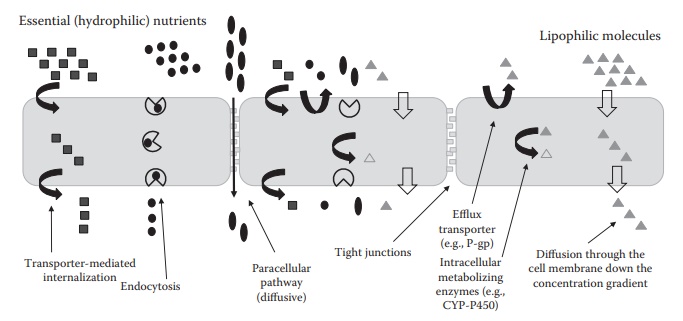Brain targeted drug delivery
| Home | | Pharmaceutical Drugs and Dosage | | Pharmaceutical Industrial Management |Chapter: Pharmaceutical Drugs and Dosage: Organ-specific drug delivery
Drug delivery to the brain, or the central nervous system (CNS), in general, is indicated in several clinical situations that include tumors, Alzheimer’s disease, epilepsy, migraine, infections, inflammatory dis-eases, and conditions that are etiologically based on neurotransmitter imbalance.
Brain targeted
drug delivery
Drug
delivery to the brain, or the central nervous system (CNS), in general, is
indicated in several clinical situations that include tumors, Alzheimer’s
disease, epilepsy, migraine, infections, inflammatory dis-eases, and conditions
that are etiologically based on neurotransmitter imbalance.
1. Blood–brain barrier
Drug
delivery to the brain and the CNS is particularly challenging because of the
BBB. The BBB is a term that denotes
the special nature of the blood vessels that carry blood to the brain and the
spinal cord. The tight junc-tions of endothelial cells lining these blood
vessels are highly impervious to substances in the blood, with electrical
resistivity ≥ 0.1 Ωm. The BBB selectively allows the passage of water, certain
gases, and lipophilic mol-ecules that can diffuse through the cell membranes
(paracellular route), and through active transport (through the transcellular
route) of certain mol-ecules that are important to neuronal function such as
glucose and amino acids (Figure 15.3). Thus,
drugs that are present in the bloodstream are not able to permeate as readily
into the CNS tissue as they can into the tissue of other organs.

Figure 15.3 Routes of drug transport across the endothelial cell lining of the
blood–brain barrier (BBB) that has tight junctions. Hydrophilic molecules, such
as essential nutrients, can cross the cellular membranes through endocytosis or
tranport-ers. Lipophilic molecules cross the membrane through diffusive
transport. Presence of efflux transporters and metabolizing enzymes can reduce
the total amount of drug crossing over to the other side.
2. Drug delivery strategies to the brain
Drug
delivery strategies to the brain include the following:
1. Drug encapsulation in liposomes or nanoparticles
· Drug encapsulation in liposomes provides colloidal particles
with lipophilic and membranous exterior that can fuse with the endo-thelial
cell membranes and enable transcellular drug transport. Commercially available
liposome encapsulated drugs include amphotericin B (AmBisome) and doxorubicin
(Caelyx)
· Commercially available nanoparticulate drugs that target the
CNS include colloidal gold nanoparticles (Aurimmune) and gold-coated silica
nanoparticles (AuroShell).
2. Drug modification, for example, by preparation of a
lipophilic prodrug
· Small-molecule drugs that are generally low molecular weight
(<500 Da), nonionizable at physiologic pH, low hydrogen bond capa-bility,
and high lipophilicity can readily cross the BBB through passive diffusion.
Examples of such compounds include benzodiazepines, alcohol, and nicotine. The
lipophilicity of a drug can be increased through structural modification and/or
by preparation of a lipophilic prodrug. Examples of drugs that can diffuse
across the BBB include levodopa, γ-Aminobutyric acid (GABA), and
valproic acid.
3. Drug conjugation with an active transport substrate to
achieve recep-tor-mediated active transport
· Drug conjugation with a moiety that has endothelial cell
recep-tors for active transport across the BBB can increase drug uptake in the
brain. For example, drug conjugation with the angio-pep-2 peptide, which
targets the low-density lipoprotein (LDL) receptor, has been utilized to target
drugs and nanoparticles to the brain.
4. Transnasal route of administration
Nasal
mucosa is a highly permeable and vascularized site. The olfactory region in the
nasal passage is a small patch of tissue that contains olfactory nerve endings
and is considered a port of entry of external chemicals into the brain. In
addition, the characteris-tics of the drug that influence its permeation
through the transcel-lular route, a key challenge in utilizing the nasal route
for brain drug delivery is the ability to present the drug to this region of
absorption in sufficient concentration and for a long enough dura-tion that can
enable the delivery of therapeutic dose. Compounds such as insulin-like growth
factor I (IGF-I) have been delivered to the brain through the nasal route.
5.
Direct intrathecal or intracerebroventricular injection or placement of DDS
during invasive surgery (implant)
· Intracerebroventricular (ICV) injection of chemotherapy
agents, morphine, and antibiotics used in the treatment of meningitis is
achieved through a subcutaneously implanted reservoir in the scalp (Ommaya reservoir)
that connects to the cerebrospinal fluid (CSF) in a lateral ventricle through
an implanted catheter.
· Biodegradable SR wafers loaded with chemotherapy agents have
been used as implants in the brain. These DDSs can be placed directly at the
site of tumor following surgery.
Related Topics
